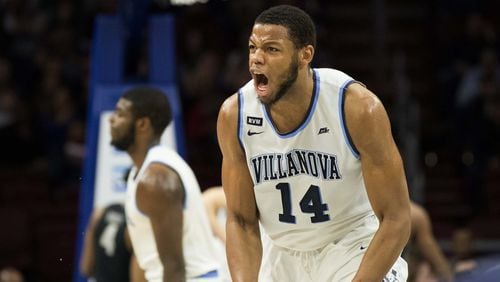At the NBA combine last month, Villanova forward Omari Spellman said he models his game after Warriors star Draymond Green. Spellman has a long way to go to reach that level, but he can take a path like Green’s to get there.
Green grew into NBA stardom by transforming his body and his game. A pudgy post-up player in college, Green shed the excess weight when he got to the NBA. He morphed from a so-so “tweener” prospect into a quick and versatile NBA big who can make plays from the wing and effectively guard most any opponent on switches.
Spellman reportedly weighed 290 pounds with 24 percent body fat when he arrived at Villanova in 2016 as a five-star recruit (he redshirted that season). At the combine, Spellman weighed 254 pounds with 13.75 percent body fat.
Following his workout with the Hawks on Wednesday, Spellman said his goal is to get down to 240 pounds with 10 percent body fat.
“Just taking my body, my craft more seriously,” Spellman said. “In high school, I really wasn’t asked to (do it). I could dominate at a ridiculous weight. But you get to the next level, and it tells you, you can’t play like that and be productive. I wanted to be successful and get better at my craft.”
Spellman’s measurements are comparable with Green’s when he was a prospect at the 2012 combine.
Green weighed 236 pounds with 11.3 percent body fat. Green’s wingspan measured 7-feet-1.25 inches compared with Spellman’s 7-feet-2. Green’s standing reach was 8-feet-9 vs. Spellman’ 8-foot-11.5.
Spellman’s greater length and bulk than Green suggest he could play more of a traditional big man role in the NBA. But Spellman has shown more potential to be a “stretch big” than Green did coming out of college: Spellman made 65 of 130 3-point attempts (43.3 percent) for Villanova.
Spellman also had good production as a shot blocker (second-best block percentage in the Big East, per kenpom.com) and rebounder (third in defensive rebounding percentage, fourth in offensive).
Green was a much better passer than Spellman in college. He also was the main cog in Michigan State’s offense, whereas Spellman ranked fourth on his team in percentage of shots attempted.
Spellman said he believes his game fits in the modern NBA.
“Ability to put the ball on the floor, ability to stretch the floor, shoot the ball, defend hard, play hard, rebound, knowing the scouting report,” he said. “Things that Villanova has taught me very well and it’s only going to help me.”
The Warriors selected Green with the No. 35 overall pick in the 2012 draft (Hawks GM Travis Schlenk was a Golden State personnel executive at the time). The pick paid off when Green developed into an All-NBA player.
A team could take a similar chance on Spellman late in the first or early in the second round of this draft. He’s old for a college freshman prospect (he turns 21 in July) but more than a year younger than Green when he was drafted as a senior.
“I’m still getting better at my craft, still getting better with my body,” Spellman said. “To be successful at this level, you can’t be heavy. I don’t want to be heavy.”







